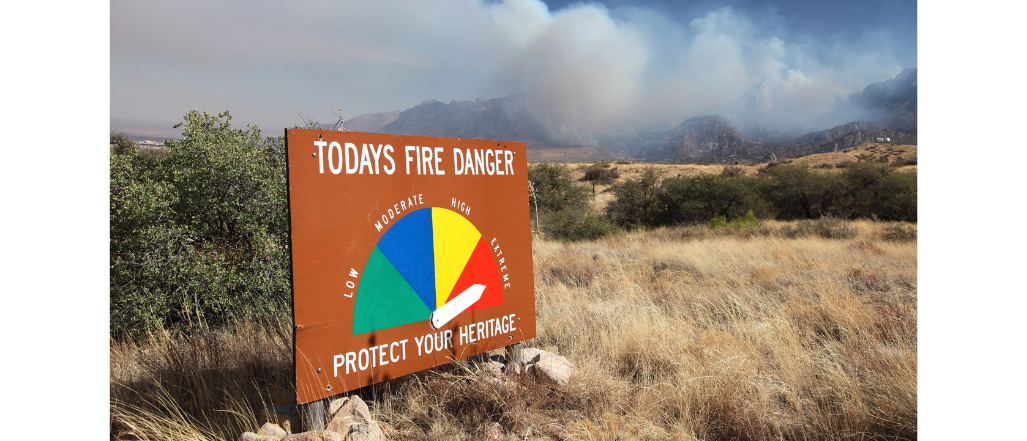Recurring cycles of drought and wildfires have homeowners asking a lot of questions about their homeowners insurance. In some parts of the country, the problem of wildfires has become so serious—and costly—that insurance companies will no longer cover homes in some areas. Wildfires in California have burned thousands of acres, and caused billions of dollars in property damage.
A wet spring can even compound the problem, if it’s followed by a period of drought, since weeds and grasses can grow rapidly with spring rains, then die off, leaving an excess of dry, flammable underbrush.
While natural causes, such as a lightning strike, can spark a wildfire, the vast majority of out-of-control blazes are started by humans, either through carelessness or intentionally.

How do I know if a fire is a ‘wildfire’?
A wildfire is defined as a fire that has grown out of control and is located in a natural area. This includes areas like forests and prairie grasslands, which will also frequently have a lot of dried-out organic material, such as grasses and trees.
Similar to hurricanes, the National Weather Service (NWS) has developed a warning system to provide residents with a better understanding of the potential threat faced when a wildfire is growing. Here are some NWS terms to be familiar with if you live in an area susceptible to wildfires:
- Red Flag Warning – A red flag warning indicates people should use extreme caution with open flames. A Red Flag Warning is issued by the NWS and local agencies as a caution, to alert people that a “fire weather pattern” is either imminent or currently ongoing.
- Fire Weather Watch – A Fire Weather Watch means that weather conditions could result in a wildfire.
- Extreme Fire Behavior – This alert means that a fire has been spotted and conditions are such that it could burn beyond the ability of firefighters to control it. To reach this alert level, one or more of the following four criteria must be observed:
- The fire is moving fast
- Crowning and/or spotting has been observed
- “Fire whirls” have been spotted
- The presence of a strong convection column
Which areas are more susceptible to wildfires?
You might be surprised to learn that while California is the highest-risk state for wildfires, more wildfires occur in the eastern U.S. than in the west. That’s according to the National Interagency Coordination Center, an organization that coordinates the response to wildland fires in the U.S. Eastern fires are typically smaller, but due to the increase in homes being built in what is known as the “wildland-urban interface,” the risk of wildfires threatening homes is rising dramatically.
Here are some of the states most affected:
Wildfires in California
The impacts of California’s multiyear drought can be seen in the number of wildfires that the state experiences every year. While some areas of the state were drenched by Hurricane Hilary, many others remain very dry and susceptible to fires. California’s ongoing drought conditions and the wildfires that start because of it have led to billions of dollars in damage, leading some large insurers to stop offering wildfire coverage in the state.
Wildfires in Colorado
Colorado is just behind California in the number of homes deemed at risk of damage or destruction from wildfires. A recent report estimates that more than 300,000 homes are at risk, primarily in the Denver and Colorado Springs areas.
Wildfires in Nevada
Nevada’s risk for destructive wildfires is increasing, largely due to the expansion of the “wildland-urban interface” mentioned earlier. As building continues in areas that are susceptible to wildfires, risk increases.
Wildfires in Oregon
The Pacific Northwest is often thought of as a wet, rainy place, so it sometimes surprises people to learn about the fire risk here. Oregon’s rain does help to tamp down fires. However, the region’s popularity for outdoor recreation contributes to the risk—along with heavily forested areas.
Wildfires in Washington
Washington State is also a popular area for hiking, camping, and other outdoor activities. More people in the woods is suspected to be a major factor in the increase in forest fires in the Northwest.
Although these are the states where wildfires have the potential to cause the most damage, drought conditions can raise the risk just about anywhere. Both Hawaii and Louisiana have experienced destructive wildfires in 2023.
Is wildfire smoke covered by homeowners insurance?
Repairing smoke from wildfires is typically covered by a standard homeowners insurance policy, but this coverage can vary by region and by state. As mentioned earlier, because wildfires are occurring more frequently and doing more damage in some areas, some insurers are reducing coverage or refusing to underwrite policies at all.
Wildfires generate different types of smoke depending on the type of fire burning. Firefighters will assess the type of smoke to determine things like a fire’s volume, location, and speed. For example, thin, black smoke indicates a well-ventilated fire, while thick, dense, white smoke is a sign of steam being present.
Smoke can cause more than just visible damage to a home. In addition to depositing soot, which a homeowner can see, the smell of smoke can permeate porous surfaces such as carpets, window coverings, and even drywall. If there’s been a wildfire in the area nearby and you suspect smoke damage, you should contact your insurance agent for an assessment.
Does homeowners insurance cover wildfires?
Because wildfires have become so large and so destructive in recent years, particularly in western states, coverage can vary by geographic area. If you live in a wildfire-prone area, check your policy or talk to your insurance agent to see what coverage you have.

Where can you apply for homeowners insurance?
Many insurance companies offer online quotes and applications if you are looking for homeowners insurance that covers wildfires. With so much information available and so many choices, it can be overwhelming to tackle researching homeowners insurance online. If you want help sorting through your options, contact the experts at Guaranteed Rate Insurance. They’ll help you find the right insurance policy that will cover your belongings at the right price.
Disclaimer:
All information provided in this publication is for informational and educational purposes only, and in no way is any of the content contained herein to be construed as financial, investment, or legal advice or instruction. Guaranteed Rate Insurance does not guarantee the quality, accuracy, completeness or timelines of the information in this publication. While efforts are made to verify the information provided, the information should not be assumed to be error free. Some information in the publication may have been provided by third parties and has not necessarily been verified by Guaranteed Rate Insurance. Guaranteed Rate Insurance, its affiliates and subsidiaries do not assume any liability for the information contained herein, be it direct, indirect, consequential, special, or exemplary, or other damages whatsoever and howsoever caused, arising out of or in connection with the use of this publication or in reliance on the information, including any personal or pecuniary loss, whether the action is in contract, tort (including negligence) or other tortious action.

